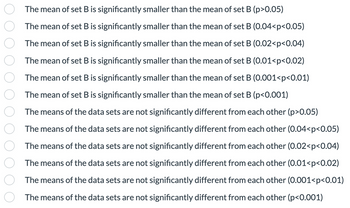
For this series of questions, you will conduct an F test and a two-tailed t-test on samples from the following data sets:
Set A: 13 , 10 , 16 , 20 , 14 , 16 , 16
Set B: 15 , 9 , 11 , 11 , 15 , 13 , 9 , 13
a.What is the calculated F value for an F test of these two data sets?
b.Based on the results of your F test, which t-tests could you do? (choose from the set of options below)
Heteroscedastic or paired, but not homoscedastic.
Homoscedastic or paired, but not heteroscedastic.
Homoscedastic, but not heteroscedastic or paired.
Heteroscedastic or homoscedastic, but not paired.
All three t-tests can be performed with this data.
Paired, but not heteroscedastic or homoscedastic.
Heteroscedastic, but not homoscedastic or paired.
c.Assuming the results of your F-test allowed it, what would the calculated t value be for a heteroscedastic t-test of this data be?
d.Assuming the results of your F-test allowed it, what would the calculated t value be for a homoscedastic t-test of this data be?
e.What is the appropriate conclusion of the appropriate t-test?(photo attached)

Trending nowThis is a popular solution!
Step by stepSolved in 4 steps with 7 images

 Glencoe Algebra 1, Student Edition, 9780079039897...AlgebraISBN:9780079039897Author:CarterPublisher:McGraw Hill
Glencoe Algebra 1, Student Edition, 9780079039897...AlgebraISBN:9780079039897Author:CarterPublisher:McGraw Hill Holt Mcdougal Larson Pre-algebra: Student Edition...AlgebraISBN:9780547587776Author:HOLT MCDOUGALPublisher:HOLT MCDOUGAL
Holt Mcdougal Larson Pre-algebra: Student Edition...AlgebraISBN:9780547587776Author:HOLT MCDOUGALPublisher:HOLT MCDOUGAL Big Ideas Math A Bridge To Success Algebra 1: Stu...AlgebraISBN:9781680331141Author:HOUGHTON MIFFLIN HARCOURTPublisher:Houghton Mifflin Harcourt
Big Ideas Math A Bridge To Success Algebra 1: Stu...AlgebraISBN:9781680331141Author:HOUGHTON MIFFLIN HARCOURTPublisher:Houghton Mifflin Harcourt


